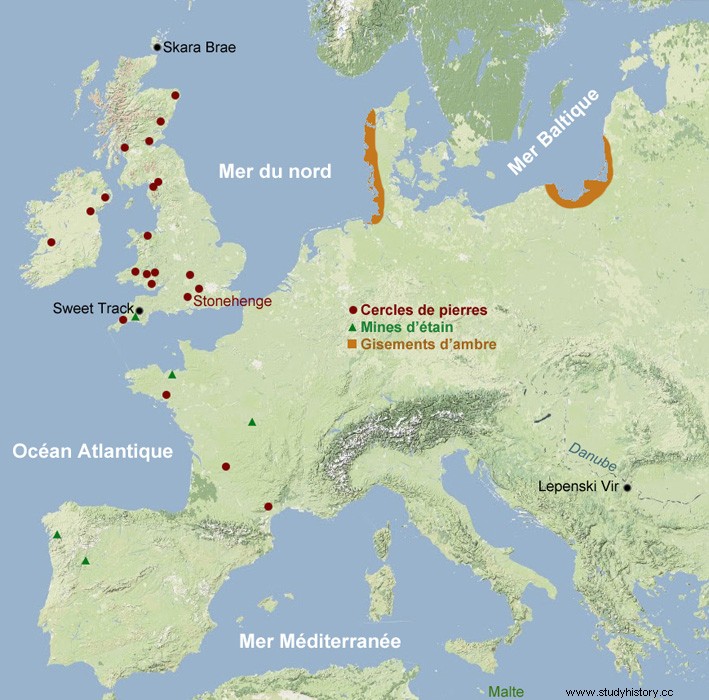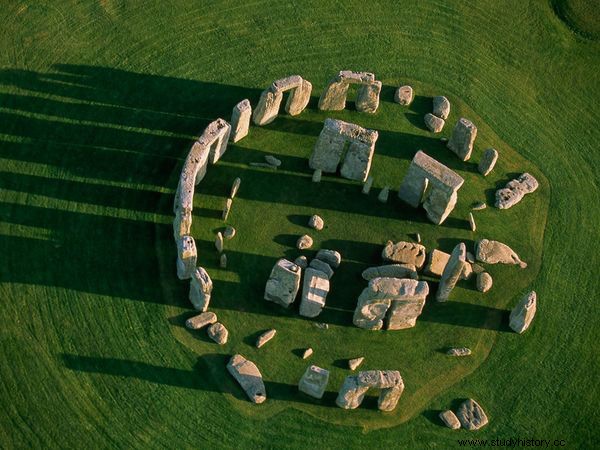
CIRCA 10,000 BC
Beginning of the Neolithic period:
After the last period of glaciation a few millennia earlier, the climate in Europe becomes mild and the forests numerous. They are populated by various animals and the first European men rely on the hunting and the picking to feed onself. They settle in camps where they find food, and move with the seasons.
CIRCA 6000 BC
The first villages in Europe:
Some places allow European men to feed all year round, especially on the banks of the Danube which is a river full of fish. Fishermen build the village of Lepenski Vir there. (current ex-Yugoslavia!) and settled there.
CIRCA 5000 – 4000 BC
Agriculture is spreading across much of Europe:
Agriculture that first developed in the Middle East begins to disrupt life in Europe. In the vast forests that cover almost the entire continent, European peasants clear plots of land to cultivate them and they use the wood to build houses. The agglomerations in Europe do not exceed a hundred inhabitants.
CIRCA 4500 BC
Construction of the first stone tombs:
In Western Europe, huge earth mounds cover stone tombs that have multiple chambers, large enough to house nearly 40 bodies.
CIRCA 4000 TO 2000 BC
Copper Age:
European men use copper , the metal and gold to make tools and various objects. Around 2,900 BC, they also made sturdy flint daggers. , wood handles , more dangerous and harder than metal blades.
War appears:
Agriculture causes an population increase and is accompanied by over-exploitation of land . The lack of new available space creates tensions between Europeans and obliges human communities to organize themselves to defend their territory, their property, preserve their livestock and their wealth. There are traces of fire in the cities, graves where the men are thrown pell-mell, their skulls sunk in, flint points planted between their ribs. The victors probably practice ritual cannibalism , as evidenced by the human remains found mixed with food in the charred ruins of certain “fortresses” in the Hérault or in the cave hearths of the Var .
The hierarchy is more and more marked:
European warriors dominate those they defend and society becomes increasingly hierarchical . More and more rich tombs appear in cemeteries in order to affirm for eternity the omnipotence of the deceased and his family.

CIRCA 3,800 BC
Building Sweet Track:
In some marshy areas, Europeans build long wooden sidewalks that allow them to go from one village to another. In present-day South West England is Sweet Track which extends for almost 2 km.
CIRCA 3500 BC
Villages become cities:
Slowly, some small villages come together and become cities surrounded by huge boulders. A Tarxien , on the Island of Malta today, men erect temples and sacrifice animals there to their mother goddess.
CIRCA 3200 BC
Stone circles:
The peoples of northwestern Europe begin to erect large stone circles and alignments of standing stones. Some experts believe that these mysterious monuments were gigantic calendars , and others believe they were used to glorify the dead .
CIRCA 3100 BC
Skara Brae build:
In some villages like Skara Brae north of present-day England in the Orkney Islands , there are no trees and the inhabitants build their houses and their furniture in stone .

CIRCA 3000 – 1500 BC
Building Stonehenge:
The most spectacular stone circle erected by European men during antiquity is Stonehenge in the south of England current. This construction was built in stages over a period of more than 1,000 years.
CIRCA 2500 BC
Bronze manufacturing (Bronze Age):
Blacksmiths make bronze by mixing copper and tin . Weapons and tools created from bronze are highly prized as they are much stronger than copper. Pewter is only found in certain parts of Europe, so most people have to buy it. The Scandinavians exchange the metals they need for amber shores of the Baltic Sea .
